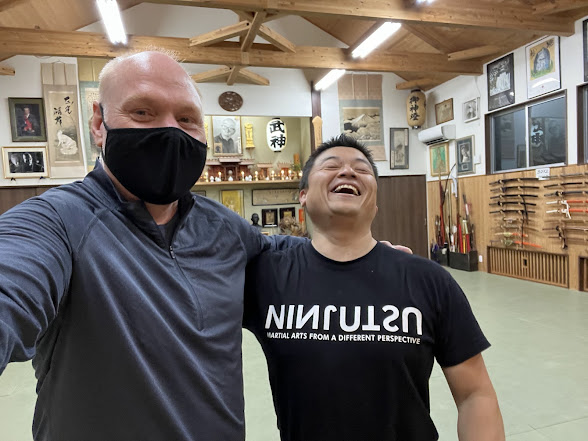Snake Hollow: Japan Report Six 令和6年
From Bujinkan Santa Monica by Michael
This morning in Japan, I got up early to visit 蛇窪神社 Hebikubo Jinja. “Snake Hollow” shrine was founded during the Kamakura period in 1323. The white snake has a close association with Benzaiten, and symbolizes living a life with a pure heart and dedicated to kindness. Since 2025 is the year of the snake, I thought it would be nice to pay my respects.
I started by taking advantage of the 撫で白蛇 Nade Shirohebi. I’ll let you translate that one! But this feature of the snake hollow shrine was supposed to bring good fortune and health, so I held my wife in my thoughts since she has been struggling lately.
Then I visited the 銭回し Zeni Mawashi and 銭洗い所 Zeni Arai-sho. This is where you bless your money and wash it to purify. The mawashi helps to circulate wealth more freely among people. And the washing cleanses in case there were any ill gotten gains. I guess it is a sort of spiritual money laundering!
Of course I brought my 集印帳 shūin-chō and received a nice stamp for the year of the snake. Then I donated to snake hollow shrine in exchange for some 御守 omamori. I like to bring these home for my students to help connect them to Japan and share whatever blessings I’ve found there.
Rant at Snake Hollow
At snake hollow, I stumbled across something that was new to me, a 愚痴壺 Guchi tsubo, which is a complaint pot. You lift the lid and complain into the hole of the jar about whatever troubles you may have. Then close the lid, leaving them in the jar. Of course I had a lot to yell into the jar.
BEGIN RANT: The ego in in martial artists! I meet students who come to class, and when presented with a technique, they decide that it won’t work. They decide that there is something wrong with the technique, or even the teacher. Even though the reality is they can’t do it properly.
This always makes me wonder, why are they there? Why did they come to the class? Obviously not to learn.
They say things like, “That would never work on the street.” Or, the teacher will demonstrate, and the student does something completely different because they decided the technique is bad. It is a self-fulfilling prophecy because they never learn how to do what is being taught. So of course it won’t work. These students have trapped themselves with their own opinions.
What is an alternative? As Hatsumi Sensei says, “Play!” If you watch baby animals “play” fight, that is not real combat. But they are preparing for real life and death situations. Or you can train like musicians who “play” and instrument and improv with other musicians.
These Bujinkan methods are the opposite in attitude of those self-appointed “serious” martial artists. You know the kind who train formal and stiff and think they know everything. They think everything should be dressed up as “real” so they can win in the ring or survive on the street. But they do not understand that their pretend “reality” training is a trap they put themselves in.
I feel like a playful attitude will help you survive. This is what Soke has always said. And it is a key to training honestly. END RANT
Training with 中川将志 Nakagawa Shōshi
Later that night, I went to Nakagawa’s class. I’ve known him for many years and used to partner up with him in Hatsumi Sensei’s classes. Lately, I’ve also trained with him in Furuta’s dojo. So I was looking forward to his perspective.
 |
| I just explained to him what his tshirt meant |
This feels like exploring new ground. It is very easy as a student to fall back on what you know. Then when something is not working you can use tricks that you’ve developed over the years. But the point of going to class is to learn something new.
He seemed really excited to be teaching. He kept going and going with no breaks. After two and a half hours he finally noticed the clock.
I really appreciate his love and enthusiasm for training. Some teachers kind of “phone it in” and just do the bare minimum. I won’t say who, but maybe you’ve been to one of their classes. It seems like they just show up to collect money.
But with only eight students, Nakagawa-san was very engaged. It’s great to see that kind of energy and spirit for sharing. Any student or teacher would do well to emulate his attitude in the dojo.












